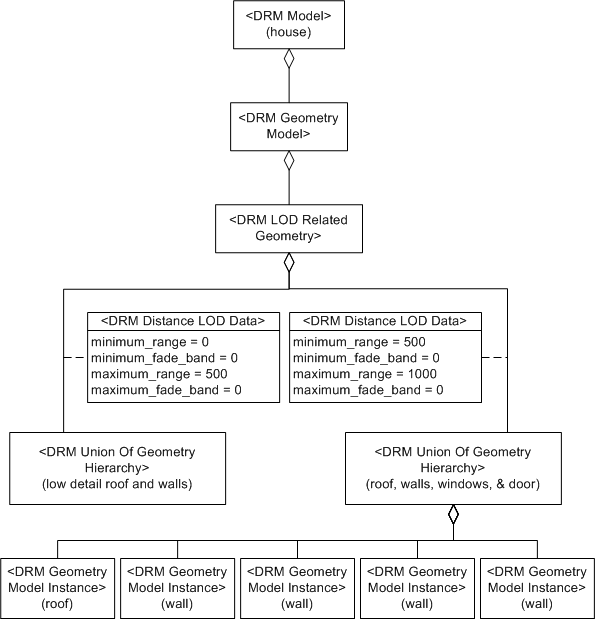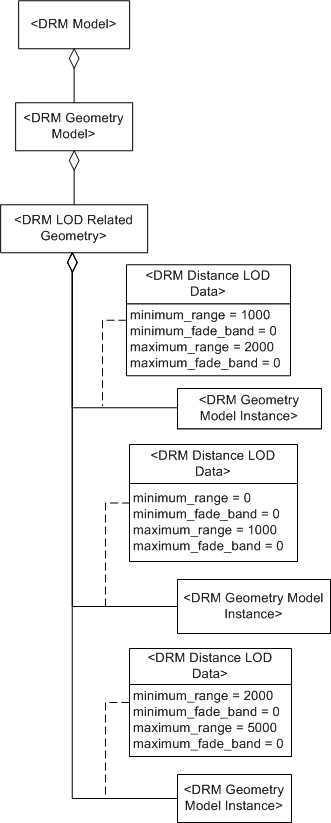Class Name: LOD Related Geometry
Subclasses
This DRM class is concrete and has no subclasses.
Definition
An instance of this DRM class specifies an aggregation of
<Geometry Hierarchy> components in which each
<Geometry Hierarchy> component is
an alternate representation of the same entity at a different
level of detail. Each <Geometry Hierarchy> component
is a collection of <Geometry Representation> instances
with a different, possibly overlapping,
<Base LOD Data> link object field value, representing
an alternative that should be used at different levels of such
distinctions as viewing ranges, map scales, or spatial resolution.
Primary Page in DRM Diagram:
Secondary Pages in DRM Diagram:
This class appears on only one page of the DRM class diagram.
Example
Consider a <Model> instance representing a house,
organized based on viewing ranges. If the viewer is farther away
than 1000 metres, the house is not visible. From 500 metres to 1000 metres,
the roof and walls are visible but not in great detail. From 0 metres
to 500 metres, the windows and door become visible. Consequently,
the <Model> instance is visible at two distance-related
levels of detail: 0-500 metres, and 500-1000 metres,
as depicted in Figure 31.

Figure 31 — <DRM LOD Related Geometry> house example
For the more detailed 0.0 - 500.0 metres,
different "wall" <Model> instances
are instanced for the walls containing the windows and doors; otherwise,
the structure of the two levels, for this example, is similar.
Three <Model> instances representing a given building
are created, each with different <Polygon> instance counts.
The most accurate representation is useful up to a viewing distance
of 1 kilometre, the second from 1 kilometre to 2 kilometres,
and the third for 2 kilometres to 5 kilometres.
To indicate this, a fourth <Model> instance can be
created as depicted in Figure 32:

Figure 32 — <DRM LOD Related Geometry> building example
FAQs
No FAQs supplied.
Constraints
Associated to (one-way) (inherited)
Associated by (one-way) (inherited)
Composed of (two-way) (inherited)
Composed of (two-way)
Composed of (two-way metadata) (inherited)
Component of (two-way) (inherited)
- zero or more <Alternate Hierarchy Related Geometry> instances, each through the use of a <Hierarchy Data> link object
- zero or more <Animation Related Geometry> instances
- zero or more <Classification Related Geometry> instances, each through the use of a <Classification Data> link object
- zero or one <Environment Root> instance
- zero or one <Geometry Model> instance
- zero or more <LOD Related Geometry> instances, each through the use of a <Base LOD Data> link object
- zero or more <Octant Related Geometry> instances, each through the use of an <Octant Data> link object
- zero or more <Perimeter Related Geometry> instances, each through the use of a <Perimeter Data> link object
- zero or more <Quadrant Related Geometry> instances, each through the use of a <Quadrant Data> link object
- zero or more <Separating Plane Relations> instances, each through the use of a <Separating Plane Data> link object
- zero or more <Spatial Index Related Geometry> instances, each through the use of a <Spatial Index Data> link object
- zero or more <State Related Geometry> instances, each through the use of a <State Data> link object
- zero or more <Time Related Geometry> instances, each through the use of a <Time Constraints Data> link object
- zero or more <Union Of Geometry Hierarchy> instances
Notes
Associated to Notes
An association between a
<Feature Representation>
instance and a
<Geometry Hierarchy> instance
indicates that the environmental object(s) that they
represent have the semantic relationship indicated by
the <Base Association Data>
link object on the association relationship.
An association between two
<Geometry Hierarchy> instances
indicates that the environmental object(s) that they
represent have the semantic relationship indicated by
the <Base Association Data>
link object on the association relationship.
Associated from Notes
An association between a
<Feature Representation>
instance and a
<Geometry Hierarchy> instance
indicates that the environmental object(s) that they
represent have the semantic relationship indicated by
the <Base Association Data>
link object on the association relationship.
An association between two
<Geometry Hierarchy> instances
indicates that the environmental object(s) that they
represent have the semantic relationship indicated by
the <Base Association Data>
link object on the association relationship.
An association from a
<Hierarchy Summary Item>
instance to a <Geometry Hierarchy>
instance indicates that the
<Hierarchy Summary Item> instance
summarizes that <Geometry Hierarchy>
instance.
An association from a
<Reference Surface> instance to a
<Geometry Hierarchy> instance indicates
that the <Geometry Hierarchy>
instance organizes the geometric objects that specify
the reference surface geometry of the
<Reference Surface> instance.
Composed of Notes
In the case where multiple
<Collision Volume> components are
specified for the
<Aggregate Geometry> instance,
the union
of the volumes thus specified is used in collision detection.
An <Aggregate Geometry> instance can have
an <LSR Transformation> component only when the
<Aggregate Geometry> instance is within
the scope of an LSR 3D SRF.
Fields Notes
If the value of the
unique_descendants
field is SE_TRUE, each
descendant of this aggregation, that is, each
<Geometry Representation>
instance that exists in the component tree
rooted at the <Aggregate Geometry>
instance shall be unique, in the
sense that it shall appear in only one branch
of this aggregation.
If unique_descendants
is SE_FALSE, at least one
<Geometry Representation> instance
appears in more than one branch of the aggregation.
If the value of the
strict_organizing_principle
field is SE_TRUE, each
branch of this aggregation
strictly complies with the organizing principle for its
particular subclass. If this value is
SE_FALSE, at least
one branch does not strictly comply with the given
organizing principle. See the organizing principle constraint
for each specific subclass for details.
The lod_data_type
field specifies the subclass of
<Base LOD Data> of
each link object in the given organization.
Prev: LOD Related Features.
Next: LSA 2D Location.
Up:Index.

